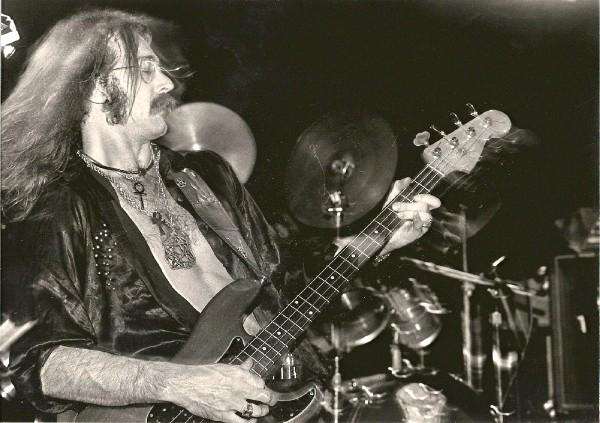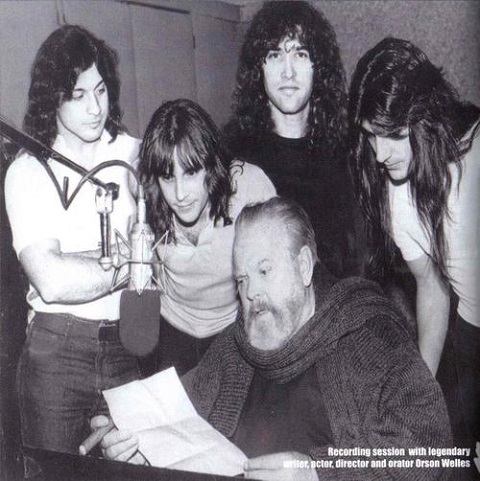
A salute goes out to Misters Imladris and Kaelrok for sharing recommendations and insights related to the subject at hand.
After having recounted and commented on the birth and evolution of the first wave of European power metal in part II, the time has come for this author to travel across the Atlantic and take a closer look at the contemporaneous development of power metal in North America, commonly referred to as United States Power Metal (USPM).
Despite the regional connotations, the term USPM is habitually invoked when speaking of Canadian bands of the times that operated with similar musical parameters as well, or even acts from other Anglo-Saxon-dominated areas such as Australia or England. Moreover, the moniker has over time come to be employed as a stylistic signifier for bands across the globe who adopt characteristics associated with the original US power metal movement.
The reason for imposing a time limit (the 1980s) has more to do with the scope of the subject as the specifics of the material. It may be difficult to grasp today, but US heavy/power metal of the 1980s was quite prolific, with heaps of albums released each year, even if in small print runs. Although suffering from a lack of mainstream attention, power metal in the US didn’t disappear at the turn of the 1990s but fell into the background as the musical and cultural climate changed significantly. The rise of underground subgenres such as death and black metal at the expense of the increasingly mainstreamed heavy and speed metal of the day had a significant impact on the metal world at large. Many bands who had enjoyed at least moderate success during the 1980s were either forced underground or disappeared completely, whereas others adapted according to the newly posed conditions.
Origins
Like European power metal, the origins of USPM can be traced back to the post-NWOBHM, early-to-mid 1980s where it developed more or less in tandem with what was happening in the Old World. However, it is difficult to point at a specific point in time where USPM was born, not least because the term was used in a variety of musical settings.
Some refer to Legend’s Fröm the Fjörds (1979) and the early albums by Manilla Road as a starting point, whereas others consider the first demo recordings by heavy metal-styled pioneers such as Manowar (1981), Queensrÿche (1982) and Warlord (1981) as the urtexts of USPM. To confuse things further, it can also be mentioned that Metallica’s second demo was christened Power Metal (1982)! What can be ascertained though is that US power metal emerged as a direct reaction to the influx of NWOBHM-related music in the North Western hemisphere, with bands like Angel Witch, Iron Maiden, Judas Priest, Motörhead and Satan leaving a decisive mark on the burgeoning movement.
This might be received as a provocative statement by some, but one could make a good argument for US power metal (in the widest application of the term) being the first expression of heavy metal “proper” in the United States. Although the United States has a strong and long-standing tradition of heavy music dating back at least as far as the 1950s, the lion’s share of indigenous bands described as heavy metal before the 1980s (Blue Cheer, Iron Butterfly, Kiss, Van Halen, etc.) would be more accurately defined as hard rock. They had the heavy riffs, pummeling percussion and soaring vocals, but the music, lyrics and general attitude gravitated too close to the blues/rock paradigm to be accepted as genuine heavy metal. The embrace of British bands in the early 1980s caused something of a paradigm shift, as it provided the necessary inspiration and tools for the establishment of a genuine form of North American metal; much like the NWOBHM had previously “saved” heavy metal from complete degeneration into stadium rock spectacle.
General Characteristics and Influences
When it comes to composition, spirit and extra-musical components, USPM remains faithfully aligned to classic heavy metal. This applies to musical syntax (focus on the interaction between high-pitched yet controlled vocals and guitars, riffs built from sequences of power chords, dual-lead guitar harmonies, predilection towards natural minor/pentatonic/modal tonalities, 8th/16th-note or triplet-based galloping rhythms, etc.), song structure (extended verse/chorus format), lyricism (revolving mythology, history, the fantastic) and spirit (fiercely romantic, celebrative of force, power of imagination and wisdom attained through tribulation).
Despite its grounding in heavy metal (NWOBHM in particular), USPM was not a carbon copy of the former but rather a regional adaption and extension furthered by the influx of musical elements from related styles and genres. Speed metal in particular, but also more archaic forms of heavy metal, hard rock and 1970s progressive rock exerted a strong influence on 1980s USPM. Although it’s difficult to single out the most important inspirational sources, honorable mentions should be awarded to Iron Maiden, Judas Priest, Black Sabbath (Heaven and Hell-era in particular), Mercyful Fate and Metallica.
The tendency to recontextualize and extend upon preceding forms of heavy metal is one of the defining traits of the subgenre and, some would say, one if its main strengths. Renovation occurred in many fields, including rhythm, melody, texture, technique and song structure. Moreover, US power metal – especially when compared to its European counterpart – is often described as inhabiting a characteristic grit, or power, unique to the subgenre. When one of the commenters on part I of this series described US power metal as “heavy metal part 2”, that person was probably not far from the truth.
It is also worth noting that even if most bands of the movement shared the same set of musical influences and aligned themselves with the romantic/fantastic in terms of extra-musical aesthetics and lyricism, the individual results come across as highly differentiated. Compare for example the music of Jag Panzer, Agent Steel and Crimson Glory: each band evinces a strong influence from Iron Maiden yet approaches the source material in very different manners. Whereas power metal in Europe coagulated into a shared set of musical and aesthetic markers – especially after the release of Helloween’s Keeper of the Seven Keys diptych – early US power metal was a sprawling mélange loosely held together by a sense of shared origins and direction. As was mentioned in the introductory part of this article series, US power metal is most accurately described as an artistic movement encompassing several related substyles rather than a specific musical style in itself, even if the term would eventually come to be used as a stylistic and/or generic signifier. That is not to say that USPM lacks internal cohesion, but there’s a certain moldability to the term that exceeds the scope of European power metal.
Sub-styles
In what is presumably an attempt to apply structure to the relatively diversified US power metal movement of the 1980s, earlier chroniclers have suggested a division between so-called blue- and white collar-styled USPM. The former grouping – represented by bands like Attacker, Jag Panzer and Omen – is frequently described as pertaining to a gritty, riff-centered, often speed metal-influenced sound. A typical white collar USPM band on the other hand – examples include Crimson Glory, Fates Warning and Queensrÿche – displays a more elegant, melodic and progressive-oriented form of power metal.
There’s a certain attraction with such a clear-cut, binary method of categorization, as can be attested to by taking a quick glance at presently available online guides to USPM. However, this blue/white collar dichotomy isn’t free from complications. Not only does it fail to capture the nuanced and diversified nature of the subgenre, it is also rendered somewhat redundant by the fact that many bands combine elements of both categories, whereas others fit into neither category. Categorizing music is almost always accompanied with a good deal of arbitrariness, but that doesn’t legitimate continued use of a model with obvious shortcomings (not to mention that the idea of haphazardly organizing metal music in accordance with socio-economic classes leaves a pseudo-socio-scientific aftertaste).
Rather investing too much time in labeling and sorting bands into more or less arbitrary categories, the focus at present should be on capturing the essentials and particularities. The quintessential element present in all forms of USPM doubtlessly stems from its rooting in heavy metal as described above. From this vantage point, bands took different routes (speed metal, progressive, melodic, etc.) but kept the heavy metal core intact. It’s most surely possible to construct some sort of USPM style-chart out of this, but that will have to be undertaken at a later stage by someone with a genuine interest in such an endeavor.
1980s US Power Metal Compilation and Reviews Archive: A Work in Progress
As with Part II, this introductory text is accompanied with a playlist. The listener will surely notice that many of the tracks are borderline cases in the sense that they happily cross stylistic borders. This is part of the charm with USPM and is really more of a strength than a source for critique. Rather than providing brief comments on individual bands and tracks as has been the practice earlier on, each of the featured acts will receive a more thorough review at a later stage. This is quite an undertaking but should be benefitable as it allows for more detailed accounts, something which is lacking in the more generalized treatment displayed above. Suggestions and comments on the selection (what deserves to be added? what should be omitted?) are warmly welcome.

Tags: fates warning, Introduction to Power Metal, manowar, USPM


The most heterosexual article on this website
I don’t know what’s on the compilation but if Twisted Tower Dire aren’t on it, you’d need to accommodate them, although not from the 80’s, they are perhaps one of the finest exemplars of Power Metal. Crest of the Martyrs is some of the finest Power Metal ever written.
A follow-up article covering the 90s and beyond will follow eventually and will, most surely, include Twisted Tower Dire.
keen to hear some close compositional analysis of the early fates warning tracks
Spectre Within and Awaken the Guardian are the shit and have some of metal’s best lyrics.